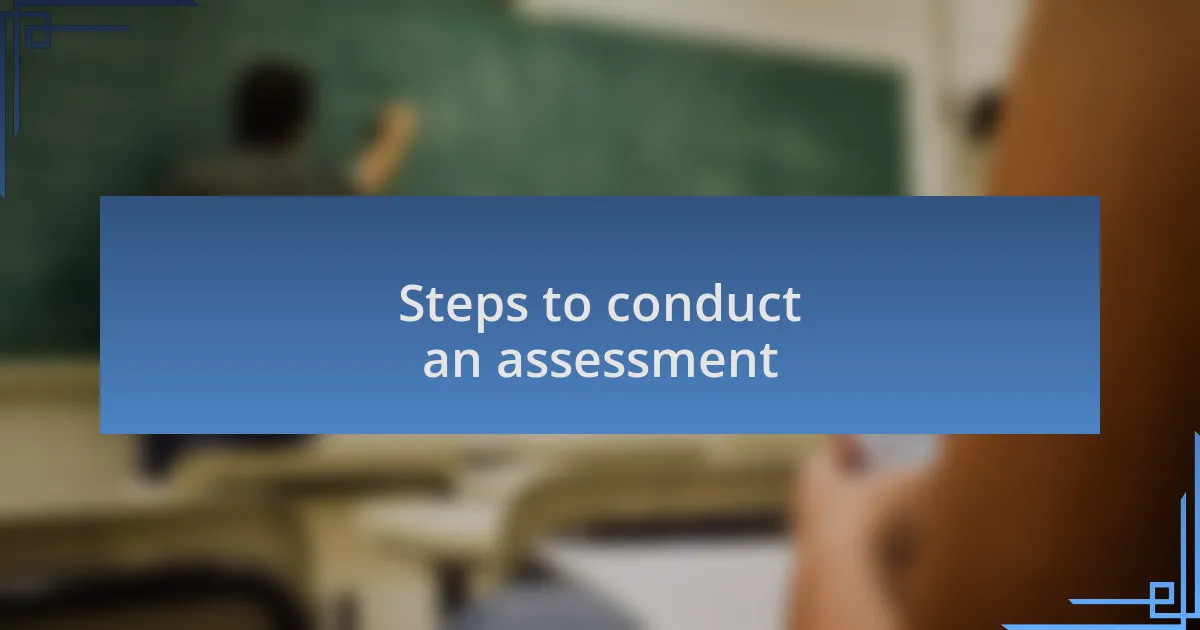Key takeaways:
- Behavioral assessments provide insights into individuals’ underlying emotional struggles, allowing for tailored support and interventions.
- Effective dyslexia training empowers educators and fosters a supportive learning environment, enhancing student engagement and confidence.
- Collaboration with parents and other professionals enriches the understanding of a student’s needs by combining insights from various contexts.
- Interpreting assessment results requires empathy and consideration of external factors that may influence a student’s performance and behavior.

Understanding behavioral assessments
Behavioral assessments are tools that help us understand how individuals think, feel, and act in different situations. I remember my first experience with these assessments when I was a new educator. The insights I gained about my students’ reactions and interactions were eye-opening. It struck me how their behaviors often communicated feelings or needs that words couldn’t express.
When discussing behavioral assessments, it’s crucial to consider their individualized approach. For instance, I once assessed a child who appeared disengaged in class. Through the assessment, I discovered that he was grappling with anxiety about his reading abilities. Have you ever noticed how a person’s behavior might mask deeper struggles? This kind of awareness can truly transform our understanding and response to those we are trying to help.
These assessments are not just about identifying issues; they’re about finding solutions that fit each individual’s unique context. I’ve often seen parents illuminate aspects of their child’s behavior that I may have missed simply because I was looking at the surface level. When we engage deeply with these assessments and evoke emotional insights, we can tailor strategies that genuinely resonate with the child’s experience and needs.

Importance for dyslexia training

Importance for dyslexia training
Training around dyslexia is essential because it equips educators and parents with the tools to recognize the signs and symptoms of this learning difference early on. I recall working with a parent who was frustrated, believing that her child simply wasn’t trying hard enough in school. After a few discussions about dyslexia and targeted training, it became clear that her child was working exceptionally hard; he just needed a different approach to learning. Isn’t it remarkable how the right knowledge can shift our perception of a child’s efforts?
Moreover, dyslexia training fosters a supportive environment that empowers both students and educators. One time, I facilitated a workshop where teachers learned about intentional interventions. We shifted our focus from traditional teaching methods to strategies like multi-sensory instruction. The transformation in how teachers interacted with their students was palpable—representing not just change in teaching style, but also a boost in student confidence and engagement.
In essence, effective dyslexia training helps dismantle barriers to learning and builds pathways to success. Think about your own experience: when you finally grasped a challenging concept, didn’t it change your entire outlook on the subject? When we provide the right training, we empower students to embrace their unique learning journeys with confidence and resilience.

Key components of behavioral assessments
When I conduct behavioral assessments, I focus primarily on gathering comprehensive information about the learner’s behavior in various contexts. One memorable case was assessing a child who seemed disengaged in class but was enthusiastic during art projects. This discrepancy highlighted the importance of observing behaviors across settings to truly understand what drives a student’s engagement. Have you ever noticed how children express themselves differently in various environments?
Another key component includes identifying patterns over time, rather than relying on isolated incidents. I had a student who occasionally disrupted lessons, but upon careful observation, I recognized that these outbursts coincided with specific challenges related to reading. This insight not only helped me understand his behavior better but also informed my approach to support him through tailored interventions. Isn’t it fascinating how patterns can illuminate underlying issues we might otherwise overlook?
Lastly, collaboration with parents and other educators is essential to a thorough behavioral assessment. I remember sitting down with a parent who had observed her child’s learning struggles at home, which provided valuable context to the behaviors I observed in school. Together, we pieced together a fuller picture of the child’s experiences, leading to more effective strategies. How often do we take the time to align insights across home and school? This partnership can truly enhance our understanding and support of students.

Steps to conduct an assessment
When I conduct a behavioral assessment, the first step is to gather preliminary information from various sources, such as school records and observations. I recall a time when I was preparing to assess a particularly shy student. By reviewing her classroom performance and speaking with her teachers, I gained a solid understanding of her academic struggles before even meeting her. How could I have effectively assessed her without this initial groundwork?
Next, I believe it’s crucial to create a comfortable environment for the learner during the assessment itself. I once set up a relaxed setting, complete with her favorite books, to help her feel at ease. This approach not only made her more willing to engage but also allowed me to observe her natural responses to reading tasks. Have you noticed how quickly students can open up in a safe space?
Finally, analyzing the data collected is key to identifying any relevant behavior patterns. I remember spending hours looking through observations and assessment results for a student who struggled with attention. I realized that his focus fluctuated significantly during certain types of tasks. This analysis not only clarified his challenges but also inspired me to adapt my teaching strategies. Isn’t it empowering to see how such detailed observations can reshape our methods?

Interpreting assessment results
Interpreting the results of a behavioral assessment requires a careful balance of analysis and empathy. One time, I had a student whose results indicated significant anxiety during reading tasks. This wasn’t just a number on a page; it signaled a deeper emotional struggle that I had to address. How can we truly support a child if we overlook the feelings behind the scores?
When examining the scores, it’s important to contextualize them within the student’s environment, learning style, and personal history. I once encountered a bright student whose assessment results revealed low comprehension skills. After further discussion, I discovered that she had been frequently moved between schools, disrupting her educational continuity. How often do we miss these contextual factors that can alter our understanding?
Moreover, I find it helpful to collaborate with other professionals—teachers, psychologists, and parents—when interpreting results. I remember hosting a meeting to discuss a student’s comprehensive assessment. It was enlightening to hear different perspectives. Each one added a layer that transformed our understanding of the student’s strengths and challenges. Isn’t it amazing how collaboration can lead to more effective strategies?

Personal insights from my experiences
Reflecting on my journey with behavioral assessments, I often recall a particular case that reshaped my approach. There was a young boy who consistently struggled through evaluations, and his results painted a dire picture. Yet, when I sat down with him, I learned he was a keen storyteller. It dawned on me that he didn’t just need academic support; he needed a way to share his thoughts. How often do we overlook a child’s unique strengths in the rush to decode their weaknesses?
Another pivotal moment came when I was debriefing assessment results with a parent who had lost faith in the system. Initially, she appeared defensive and skeptical. But as we unraveled the findings together, I watched her expressions shift from disbelief to hope. What I realized then was how crucial it is to create an open dialogue; sometimes, a simple conversation can reignite trust and foster collaboration.
In my experience, I’ve learned that the narrative behind the numbers can be a game-changer. I once supported a student who excelled in creative writing but faced hurdles in structured tasks. Connecting his passion with targeted strategies not only boosted his confidence but made learning more enjoyable for him. Isn’t that the goal? To turn challenges into stepping stones rather than barriers?

Practical applications in training programs
When integrating behavioral assessments into training programs, it’s essential to tailor interventions based on each individual’s unique assessment results. I once had a student whose assessment indicated potential issues with phonemic awareness. By implementing a training program that incorporated multisensory learning techniques, I noticed significant progress in his reading skills. It was a reminder that a single assessment can lead to targeted strategies that resonate deeply with a learner’s needs.
I remember a training session where I introduced a group of educators to the concept of using student interests to shape learning objectives. One teacher shared how a student who struggled with traditional reading tasks became engaged when asked to create comic strips based on stories. This experience highlighted how aligning training with behavioral insights can cultivate a deeper understanding of student motivation. Isn’t it fascinating how enthusiasm can transform a learning experience?
In practice, fostering a supportive environment where students feel safe to express their challenges is paramount. During another training instance, I emphasized the importance of building a community around assessment discussions. One parent remarked that after realizing her child’s difficulties, she became more proactive in advocating for support and resources. This interaction reinforced my belief: when we leverage the emotional aspects of assessments, we not only empower students but also inspire families to become active participants in the learning journey.